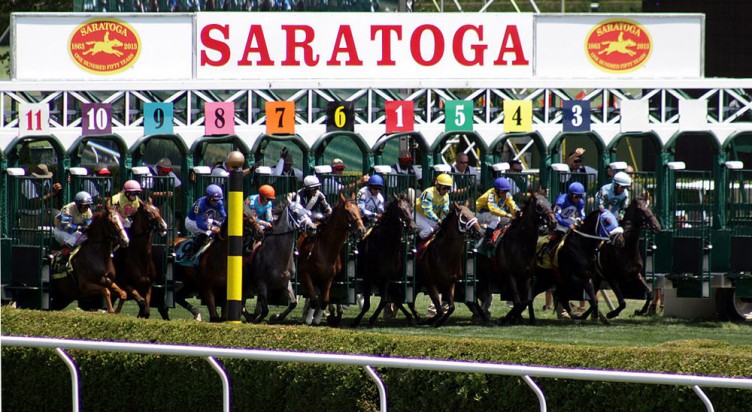In November of 2018 Greyhound racing was officially banned in the state of Florida. Florida had a rich history of Greyhound racing dating back to the first track opening in 1922. However, almost a century later, the ban did not come as a surprise to many. Animal rights activists have been campaigning to end all racing for decades. This leads to the question, will horse racing be next?
Modern horse racing started sometime around the 12th century in England. Fast horses were brought home from the crusade and bred to produce winners on the track. The first American racetrack was laid out on Long Island, New York in 1665, however the sport was not organized until after the Civil War. By 1863, the Saratoga Race Track was opened as we know it today. Since the opening of the track, The Victorian Village’s growth has been directly tied to the summer racing.
Saratoga Springs has a rich history. Originally built by the British as Fort Saratoga in 1691, the town quickly grew and was the location for two battles in the American Revolution in 1777. Before this, the springs were known by Native Americans to have healing capabilities. Nearly a century after American independence, racing and gambling made the town a summer destination point for wealthy individuals across the northeast.
In the summer months, Saratoga real estate rents at a rate exponentially higher than any other location in the Capital District of upstate New York. High summer rents raise the sale price year-round for anything in the town. Therefore it is fair to ask, would the decline of horse racing lead to real estate prices plummeting in Saratoga Springs?
Discussions surrounding the ban of horseracing have seen a new life after the failed drug tests by trainer Bob Baffert in the 2021 Kentucky Derby. Baffert is a household name in the racing world. Perhaps most known for training the 2008 and 2015 triple crown winners, American Pharaoh and Justify. This is no small task. Only 13 horses have ever won the triple crown and before Baffert, the previous winner was Affirmed in 1978. Baffert’s most recent Kentucky Derby win with horse Medina Spirit would have added to his long list of successes if it had not been tainted by a pair of failed drug tests which disqualified the horse from the race. Perhaps the most concerning part of the story is that Medina Spirit was not Bob’s first horse to fail a drug test.
Baffort grew up in Arizona and was involved in the horseracing world at an early age. As a teen he rode as a jockey and he eventually graduated from the University of Arizona’s Race Track Industry Program. The story slowly gets darker as today, Baffert has 31 horses who have failed drug tests. Notably, 2018 triple crown winner Justify tested positive for Scopolamine after winning the 2018 Santa Anita Derby. Trainers are known for keeping injured horses on the track when they should be recovering by supplying them with drugs to mask the pain. In 2020, The House passed a bill to ban drugging horses on race day. This could be seen as a solution to the entire problem or one step in the direction of banishment.
Failed drug tests are only a small part of why animal activists are campaigning to ban racing. These activists can be seen protesting daily outside of the Saratoga track in summer months. The five years leading to the pandemic over 1,000 horses per year died at American racetracks. These horses can all be tracked on sites such as horseracingwrongs.com. These numbers do not include deaths during training. Many can still remember when the popular horse Barbaro suffered a shattered ankle at the beginning of the 2006 Preakness. His owners paid the medical expenses required to get him back to full health but only because he was a Kentucky Derby winner. The average racehorse would not have survived that injury.
This article however is not stating whether or not racing should be banned, rather how will that affect real estate prices in Saratoga? Without the surge in summer rental prices, will homes sell at a lower price? Saratoga has other attractions to offer such as a lake, a small casino, a performing arts center and a growing downtown area with bars and shops, but these things don’t make it unique the way that the track does. The city’s official slogan is, “Health, History, and Horses.” The National Museum of Racing is also in Saratoga. Horseracing is a part of the identity of the city.
Not only does the track draw hundreds of thousands of racing and gambling enthusiasts every year, it considerably drives down the taxes for Saratoga County. This low tax cost is factored into home prices when buyers are comparing total expenses. If racing is gone, taxes will go up, homes will be less desirable and prices will go down.
The average home price in Saratoga County is $312,148. This compares to the $254,376 average in Albany County, $227,400 in Rensselaer County and $208,818 in Schenectady County. The average home price in the town of Saratoga Springs is $404,093 compared to the $230,616 in Albany, $204,173 in Troy and $221,780 in Schenectady. As previously mentioned, Saratoga has other attractions besides the track and a good school system that these cities lack, but the Saratoga premium pricing has always been tied to the racetrack.
Saratoga may be able to find other ways to boost the economy but none of them would be as exciting and unique as the racetrack. Short term rental rates would go down and property values would follow. Notable names would be less likely to visit and all of downtown’s business would suffer.
The short answer is yes prices would go down but finding how much, and deciphering what to do with that information, are difficult tasks. Should new investors steer clear from the market because of this concern? Should seasoned investors sell their Saratoga portfolios and move the capital to growing markets? With Saratoga prices already being at a premium it can be difficult to find long-term investing potential in the old village. Investors shouldn’t panic sell because of a hypothetical future event but they need to keep that hypothetical in mind. If they don’t, they are not being practical about society and their investments.




